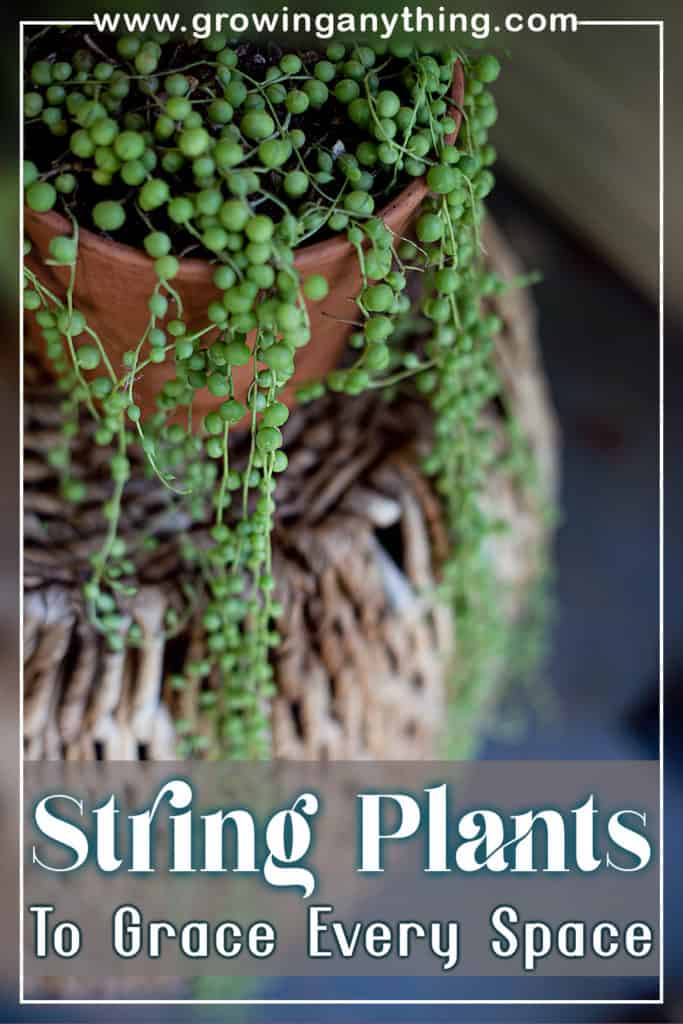18 Best String Plants
String plants are gorgeous in every indoor and outdoor setting. These trailing plants come in various shapes and colors and have some interesting names such as pickles, tacos, bananas, etc.
These plants add a touch of a boho vibe in rooms decorated in earthy colors and natural materials.
String plants can be a bit challenging to grow indoors. You need to ensure good soil mix and keep an eye on the plant’s individual needs. Some string plants may enjoy frequent misting, while others will rot if you increase the humidity.
Here are the most beautiful string plants to consider for your home!
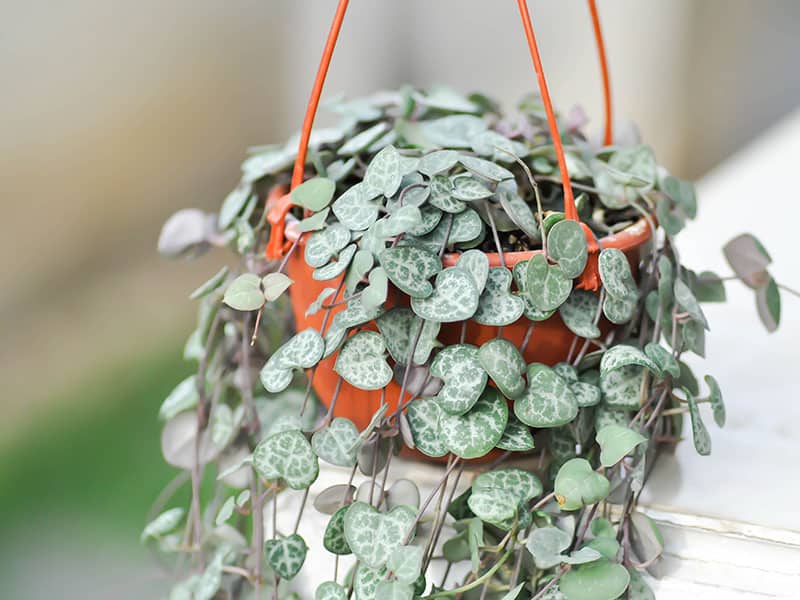
1 String of Pearls
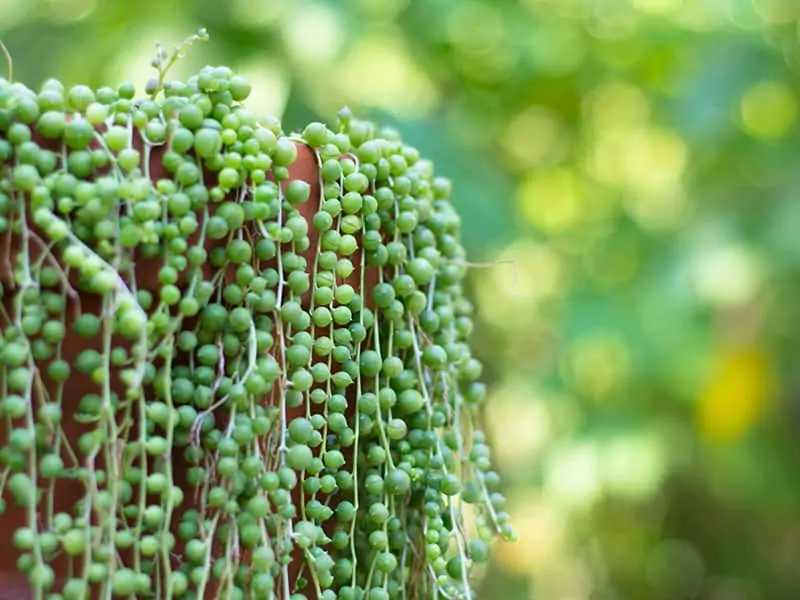
The String of Pearls plant belongs to the daisy family. The plant thrives well in bright light and can tolerate artificial light. The ide
Also, use the well-draining, preferably sandy soil or an average succulent potting mix for the plant.
The scientific name of this beautiful cascading succulent is – Senecio Rowleyanus. Overall, String of Pearls is a fast-grower, and it is easy to propagate, too. But, you need to be careful with misting and pot size to keep the plant healthy. Discover how to identify the most common problems with String of Pearls.
Most effective way to keep the String of Pearls alive
2 String of Raindrops
The String of Raindrops is a hybrid plant from the Senecio family, the same family that String of Pearls belongs to, with the botanical name Senecio rowleyanus.
The plant develops lovely raindrops-shaped foliage, hence the name. The stems are thicker and fleshier than String of Pearls, so the plant looks more robust.
It is a relatively easy plant to grow. The String of Raindrops needs consistent moisture. But, don’t water the plant too much in winter.
The ideal soil for the plant is standard cactus soil with excellent drainage. Also, String of Raindrops needs light but grows best when exposed to filtered light, because direct sunlight may burn the leaves.
If you grow a String of Raindrops outdoors, protect the plant from frost.
3 String of Watermelon
Curio herreanus or String of Watermelons has a trailing growth habit. The plant develops large and slightly elongated leaves. The leaves are also striped with dark and light green in a pattern that resembles watermelons. Interestingly, if you expose the plant to direct sunlight, the stems will turn purple!
The blooms are small and white and appear from early spring to late fall. A String of Watermelon is a drought-tolerant plant. But, don’t leave the soil dry for too long, as it can cause stunt growth.
The plant is toxic so keep it away from pets and children.
4 Burro’s Tail
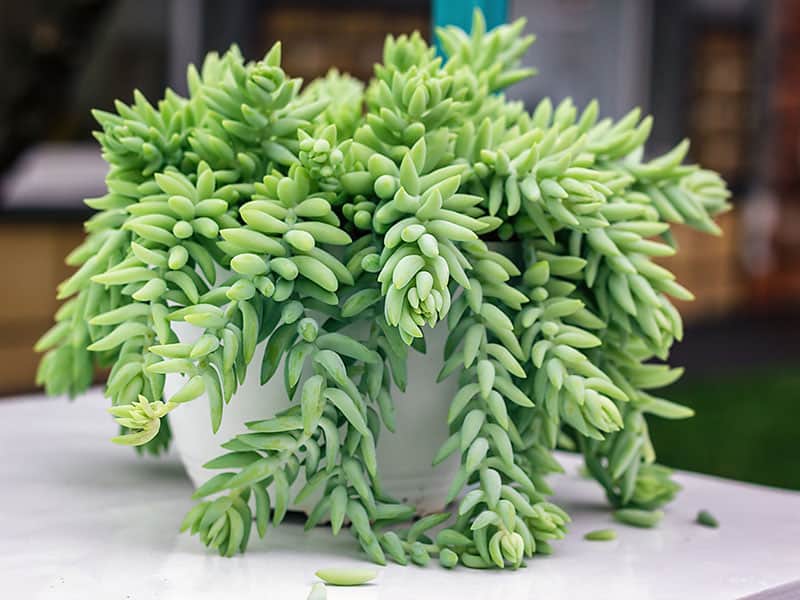
Burro’s Tail lacks the word string in the name, but it is one of the most recognizable string plants ever! The scientific name of the plant is Sedum morganianum.
The plant is resistant to heat and drought, so it is best suited for tropical regions. It develops thick stems densely covered with blue-green leaves.
Overall, the plant may look like it has chalk patina on top of the leaves, which gives it a charming look. Burro’s Tail can be grown outdoors on a patio or balcony, or indoors, near the sunny window.
It looks great in a hanging basket or a container, mixed with other succulents.
Simplified method to prune Burro’s Tail.
5 String of Nickels
Dischidia nummularia or String of Nickels is native to India, Australia, and regions of Asia. The plant is an epiphyte, which means that it grows on other plants and trees in its native habitat. It is also a type of air plant, so it takes most of the nutrients and moisture from the environment. Because of it, caring for the String of Nickels is simple.
A String of Nickels is a lovely plant but can be challenging to track down. Keep the plant in the partial sun area, and ensure well-draining soil.
Grow String of Nickels outdoors in a tropical climate year-round, or keep it indoors when the temperatures drop. The trick you can apply to keep the plant thriving is to mist the plant regularly.
Read more tips for growing String of Nickels.
6 Calico Kitten
Calico Kitten is a beautiful succulent with strings of heart-shaped foliage. Crassula pellucida is the botanical name of the plant.
The plant makes an ideal houseplant because of simple care and high visual impact. It develops lovely flowers in spring, and in some areas, the plant may re-bloom.
You can keep it in a hanging basket or use it in rock gardens. Whichever you choose, the plant will look lovely.
This succulent needs plenty of sunlight but may burn when exposed to direct sunlight. Feed the plant with fertilizer several times in the growing season, and the plant will thrive.
7 String of Hearts
The String of Hearts might be the most popular of all string plants! The scientific name of the plant is Ceropegia woodii.
You can easily recognize the plant by its trailing stems covered with little green heart-shaped leaves! Moreover, the leaves feature an attractive marble-like pattern, and the stems develop a purple hue when exposed to sunlight.
In addition, pale magenta flowers may appear year-round. But, in most cases, the plant blooms in late summer.
It looks beautiful in hanging baskets or on the sunny window sills.
The ideal conditions for the String of Hearts are acidic, fertile, well-draining soil, partial sun, and medium moisture.
Ceropegia woodii is native to Southern Africa.
8 Rattail Cactus
Rattail cactus or Aporocactus flagelliformis is a striking plant, native to Mexico. It develops long stems, which can grow up to four feet! The cactus is most beautiful in spring when the showy violet-red flowers appear. Sometimes, the flowers are multi-colored, pink, orange and violet. Unfortunately, Rattail’s cactus flowers are short-term and they only live for a couple of days. But, if you take good care of the plant, your cactus will re-bloom over and over again.
The plant needs full-sun exposure and rich soil. It is important to keep the plant consistently moist during the growing season so the plant can thrive.
9 String of Tacos
The String of Tacos, Taco plant, or botanically, Peperomia axillaris is slowly making its way into homes around the world! The plant is popular because of its long stems and taco-shaped thick leaves!
If you can get a String of Tacos, keep it in a tight container. It will help the roots to remain healthy. Additionally, the plant needs moist, rich, and loose soil, and high humidity. Ideally, your plant will be exposed to moderate lighting and will receive frost protection.
On average, the Taco plant grows up to 10 inches tall. You can propagate the plant by leaf cuttings.
10 Watch Chain Plant
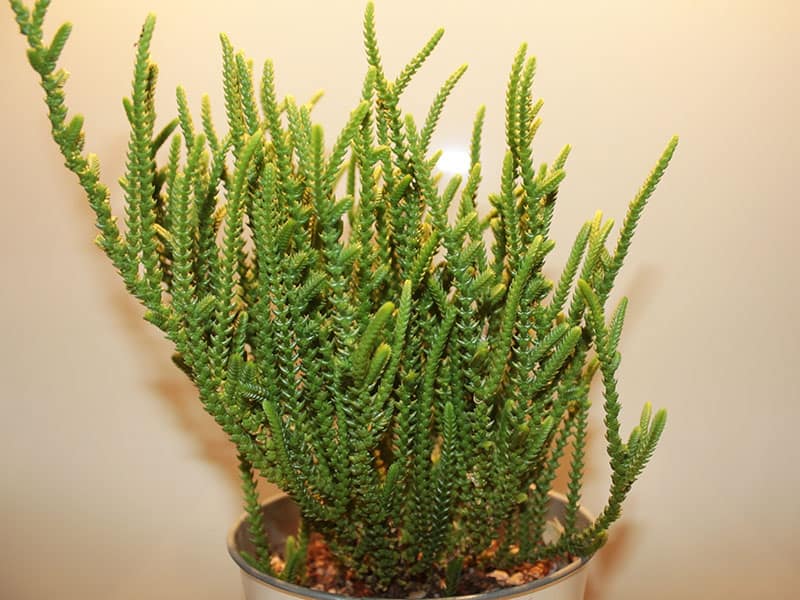
Watch Chain Plant or Crassula muscosa is a true gem in the string plants. It develops thick flesh with dense foliage.
As the plant matures, Watch Chain grows into a small bush shape.
During the blooming season, the bush is decorated with small yellowish flowers!
Watch Chain plant goes dormant in summer and has the water and sun needed like an average succulent. It means a lot of sunlight and a tiny amount of water!
11 String of Pickles
The String of Pickles, Ruby Necklace, or scientifically Othonna capensis is such a lovely string succulent. The plant features ovate foliage with red stems. When you expose the plant to direct sunlight, the leaves turn bright red.
It grows best in well-draining soil. You can use a standard cactus potting mix and let the soil dry between two waterings.
The plant blooms in summer, spring and fall, and looks gorgeous year-round! Propagation is simple – via stem cuttings!
12 String of Turtles
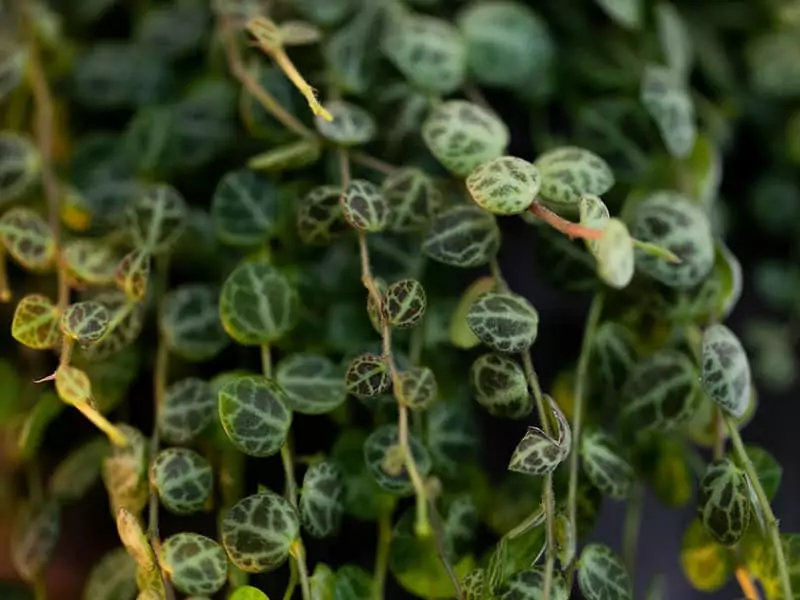
The String of Turtles is a rare and beautiful succulent. The plant thrives in tropical conditions!
The leaves feature beautiful patterns which resemble turtles’ shells.
The botanical name of tricky-to-grow-plant is Peperomia Prostrata.
When you first plant your Peperomia Prostrata, use a rooting hormone to help the roots establish faster. Also, water sparsely to prevent rotting.
If you don’t prune it, your String of Turtles may become too invasive, so remove the unwanted stems. You can also pinch new growth to prevent the development and keep the plant under control.
13 Green Button Plant
Here is another Peperomia on my list. The name is Peperomia Roundifolia Green Button, and it is an attractive plant to grow in hanging baskets or use as tabletop decor. It is one of the easiest plants to care for and will stay compact. Therefore, if you are looking for a string plant for a small space, check the Green Button plant.
Place it away from direct sunlight. The plant can survive low lighting and fluorescent light as well!
You can use perlite or gravel in the potting mix to improve air circulation and keep the roots healthy.
The plant is sensitive to salt, so wash it occasionally to prevent salt buildup on the foliage.
14 String of Bananas
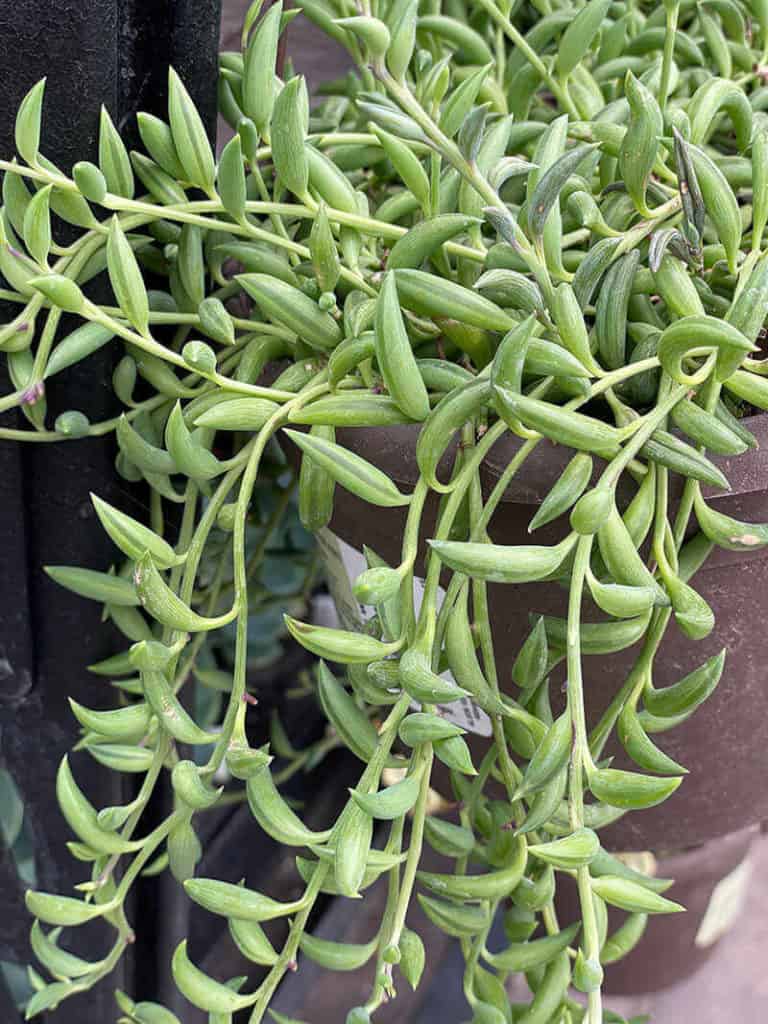
Senecio radicans or String of Bananas looks like the String of Pearls. The two plants are close relatives. It is a vining succulent plant with foliage shaped like bananas.
Like most succulents, String of Bananas thrives when fully exposed to the sun. The water needs are low, and the plant will benefit from pruning and support structures.
You can also propagate the plant easily, by using stem cuttings. All it takes is cutting the vines about two inches from the stem. Remove the loose foliage around the parts where you made the cut. Let the cutting dry completely, it will take between three and seven days.
Then, plant the cutting in the standard cactus mix and ensure the soil stays moist until the plant establishes.
The plant has mild toxic features.
Easy way to propagate String of Bananas in water
15 String of Needles
The String of Needles or Ceropegia Linearis is a trailing plant with thin and pointy leaves that look like needles. The plant care level is easy, but there are still a few tips you need to know about. The String of Needles is adaptable to different humidity conditions.
You don’t have to mist the plant to improve the humidity. But, occasionally shower your plant to remove dust and dirt and keep the plant good-looking and tidy.
Also, the plant needs regular fertilization during the growing season – in summer and spring. Reduce the fertilization frequently in the fall, and stop doing it completely in the winter. You can use whatever houseplant fertilizer you have, but the one for the cactus plant will provide the best results.
The plant needs bright, indirect light, and the soil needs to dry completely between two waterings.
Check out the complete care guide for a String of Needles!
16 String of Dolphins
Senecio peregrinus is called String of Dolphins because of the dolphin-shade foliage that develops on the trailing stems. The plant is somewhat rare but beautiful. It is a hybrid variety between String of Pearls and a Candle plant.
The plant can be grown from seeds, but the process is much more complicated and risky than growing a String of Dolphins from cuttings.
The plant develops lovely blooms, which consist of tiny flowers. They look like poms and have a sweet cinnamon aroma!
Well-draining soil, moderate light exposure, and occasional fertilizer are enough for your plant to grow.
17 String of Buttons
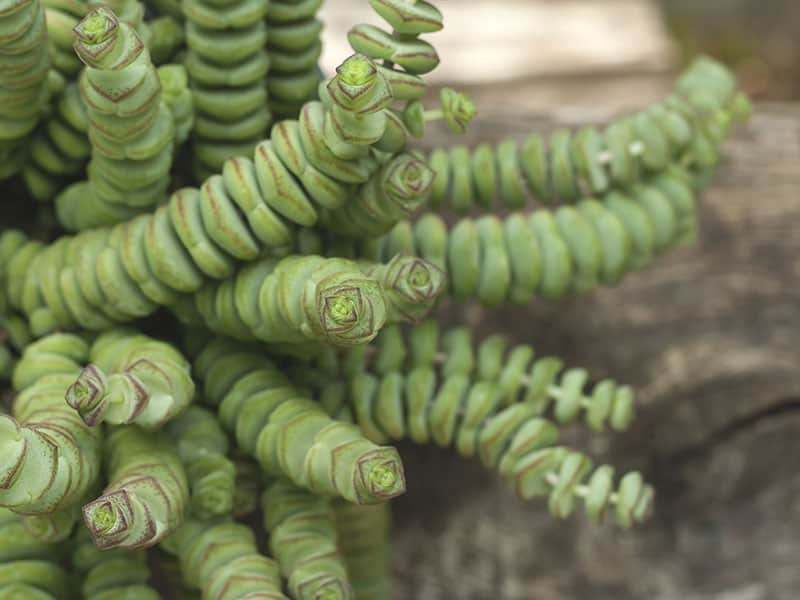
Crassula perforata or String of Buttons plant is an ideal beginner plant because it doesn’t mind being neglected.
The plant is native to South Africa, and it is quite adaptable to various conditions.
In its native habitat, String of Buttons grows on rocky slopes with excellent drainage. Overall, the plant remains moderately compact and can reach a maximum height of 18 inches.
In spring, the String of Buttons develops lovely yellow flowers.
18 Sansevieria Parva
Sansevieria Parva or Kenya Hyacinth is a type of snake plant and a great houseplant. When you provide rich, well-draining soil and don’t overwater the plant, your Sansevieria Parva will thrive!
The plant is suitable for hot and dry climates, and it can grow in dappled sunlight. It doesn’t need too much water or fertilizer.
Fantastic String Plants Are Versatile And Low-Maintenance
String plants are always trendy, whether you use them to grace your patio or as a tabletop decoration. Pruning is an easy way to keep the plant within the desired shape and size, but you can also let the plant develop on its own.
Additionally, most strong plants are easy to grow. They need only basic care and love to thrive and to remain showy!
What is your favorite string plant? I love the String of Dolphins and String of Raindrops!
Come back for more attractive plant lists and gardening tips!
